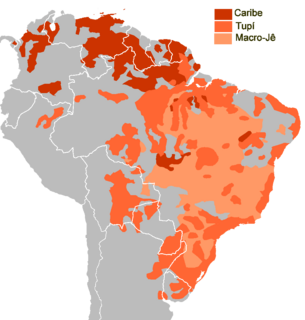
Je–Tupi–Carib is a proposed language family composed of the Macro-Je, Tupian and Cariban languages of South America. Aryon Rodrigues (2000) based this proposal on shared morphological patterns. In an earlier proposal, Rodrigues (1985) had also proposed a Tupí-Cariban language family.

The Kamayurá are an indigenous tribe in the Amazonian Basin of Brazil. Their name is also spelled Kamayura and Kamaiurá; it means "a raised platform to keep meat, pots and pans." The Kamayurá language belongs to the Tupi–Guarani family.

Arawakan, also known as Maipurean, is a language family that developed among ancient indigenous peoples in South America. Branches migrated to Central America and the Greater Antilles in the Caribbean and the Atlantic, including what is now the Bahamas. Almost all present-day South American countries are known to have been home to speakers of Arawakan languages, the exceptions being Ecuador, Uruguay, and Chile. Maipurean may be related to other language families in a hypothetical Macro-Arawakan stock.
Lucy Seki was a Brazilian linguist specializing in indigenous languages of the Americas. She authored a grammar of the Kamayurá language.
Gramática do Kamaiurá, Língua Tupi-Guarani do Alto Xingu, by Lucy Seki, is an authoritative and comprehensive description of Kamayurá, an indigenous language of Brazil.

Xingu peoples are indigenous peoples of Brazil living near the Xingu River. They have many cultural similarities despite their different ethnologies. Xingu people represent fifteen tribes and all four of Brazil's indigenous language groups, but they share similar belief systems, rituals and ceremonies.
The Panará are an Indigenous people of Mato Grosso in the Brazilian Amazon. They farm and are hunter-gatherers.

The Xingu Indigenous Park is an indigenous territory of Brazil, first created in 1961 as a national park in the state of Mato Grosso, Brazil. Its official purposes are to protect the environment and the several tribes of Xingu indigenous peoples in the area.
The Yudjá or Juruna are an Indigenous people of Brazil. They were formerly the major tribe along the Xingu River, but are now divided into two groups, a westernized northern group near Altamira, Para near the big bend of the Xingu and a more conservative group in the Xingu Indigenous Park at the headwaters of the Xingu in Mato Grosso. The southern group lives in two villages located near the mouth of the Maritsauá-Mitau River. They fish and raise crops, such as manioc.

The Mehinaku, Mehináko or Mehinacu are an indigenous people of Brazil. They live in the Indigenous Park of the Xingu, located around the headwaters of the Xingu River in Mato Grosso. They currently reside in area around the Tuatuari and Kurisevo Rivers. They had a population of 254 in 2011, up slightly from 200 in 2002.
The Suyá, self-denomination Kisêdjê, are indigenous people in Brazil, at the headwaters of the Xingu River.
The Ikpeng are an indigenous community that now lives in the Xingu Indigenous Park in Mato Grosso, Brazil. They had a population of 459 in 2010, up from a low of 50 in 1969.
Trumai is an endangered language isolate of Brazil. Most Trumai are fluent in languages of wider communication, and children are not learning it well.
The Pareci–Xingu languages, also known as Paresi–Waura or Central Maipurean, are Maipurean / Arawakan languages of the Bolivian and western Brazilian Amazon.
Amonap, also known as Apalakiri, is a Cariban language spoken by the Kuikuro and Kalapalo peoples of Brazil, and formerly by the Matipu. It is spoken in seven villages along the Culuene River in the Xingu Indigenous Park of Mato Grosso.
Mehináku (Meinaku) is an Arawakan language spoken by the Mehinaku people in the Xingu Indigenous Park of Brazil. One dialect, Waurá-kumá, is "somewhat intelligible" with Waurá due to influence from this language.
Xingú Asuriní is a Tupi–Guaraní language of the state of Pará, in the Amazon region of Brazil. The entire population speaks the language, and most speakers are monolingual.
Yawalapiti (Jaulapiti) is an Arawakan language of Brazil. The Agavotaguerra (Agavotoqueng) reportedly spoke the same language. Speakers of the language live in a village along the edge of the river Tuatuari, a tributary of the Kuluene River, located in the southern part of the Xingu Indigenous Park, in the state of Mato Grosso.

Xingu is a 2011 Brazilian drama film directed by Cao Hamburger and scripted by him, Elena Soárez and Anna Muylaert. Starring João Miguel, Felipe Camargo and Caio Blat, the film tells the Villas-Bôas brothers trajectory from the moment in which they joined the Roncador-Xingu expedition, part of the Westward March of Getúlio Vargas, in 1943.





